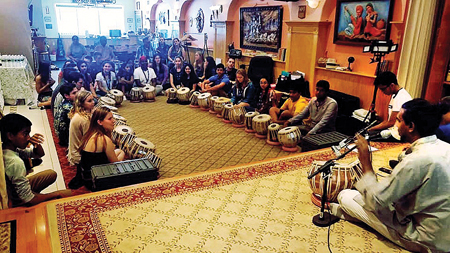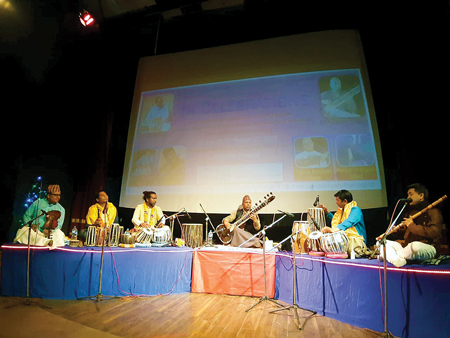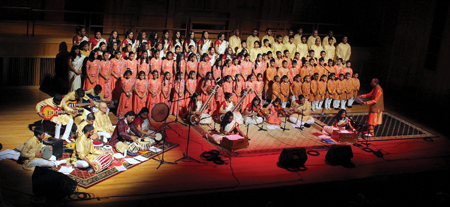Diaspora: Indo- Caribbean Beats

[Left] Despite being removed from his Indian roots for 180 years, Avirodh Sharma is steeped in Indian classical music, which he fuses effortlessly with Caribbean soca, calypso, and other world music.
Musician Avirodh Sharma’s ancestors migrated from India to the West Indies about 180 years ago as plantation workers for the British colonizers. Despite almost two centuries of displacement, a majority of them have managed to retain their culture, cuisine, language, and music while also making Caribbean culture and identity their own. Sharma provides some glimpses of this epochal journey.
In San Diego, California, a riveted audience hangs onto every minute of Dishwater Dreams, a 100-minute comic solo act in which playwright Alaudin Ullah recounts an autobiographical tale of displacement and finding roots. The emotional monologue is both funny and moving, but what also stops you in the tracks is a performance that captivates without any words. Avirodh Sharma, an Indo-Caribbean tabla player, who has given the original music to the act, manages to elicit emotions with his taalas (rhythmic patterns in classical Indian music) and tarangs (vibrations).


 According to Sharma, a renowned percussionist and composer, “It is unprecedented in American theater that emotions such as anger, despair, and exhilaration are communicated through the beats of tabla. I am showcasing tabla for its potential to create sound effects—from emotions to actions such as striking a ball!” He explains, “For instance, when the mother of the protagonist is angry, I play tabla beats to match the tone and convey the feelings. It is different from underscoring. We are showing an aspect of tabla that hasn’t been done before. We use the tones and dynamics of tabla to elucidate the emotional undercurrents of the monologue.”
According to Sharma, a renowned percussionist and composer, “It is unprecedented in American theater that emotions such as anger, despair, and exhilaration are communicated through the beats of tabla. I am showcasing tabla for its potential to create sound effects—from emotions to actions such as striking a ball!” He explains, “For instance, when the mother of the protagonist is angry, I play tabla beats to match the tone and convey the feelings. It is different from underscoring. We are showing an aspect of tabla that hasn’t been done before. We use the tones and dynamics of tabla to elucidate the emotional undercurrents of the monologue.”
Music is in Sharma’s blood. His father excelled in sitar, violin, sarod, sarangi, and bansuri; and his mother sang on radio and was called the “Nightingale of Demerara,” a historical region in Guyana.
Perhaps for Sharma, who was born and brought up in the Caribbean, expressing the intricacies of migration through music comes easy. After all, Caribbean music with its complex origins is influenced by everything—including colonial hegemony. But what remains interesting is that Sharma, whose ancestors left India close to two centuries ago, chose to practice tabla in the land of calypso and bomba.
How and why did he choose the tabla? “For my introduction to Indian music, we have to delve into the history of my family. Because it was almost unheard of to make such a big migration during those times, people held on more dearly to the traditions they left behind. As there was no other way to document where they came from and what they did regularly in their households, everything from music to food had to be preserved in practice for the fear of losing it.”
Sharma grew up in Trinidad and Tobago in an Indian-Caribbean family. His father was born in Trinidad and his mother in Guyana. Talking about his earliest interaction with Indian music, he says, “My grandfather was a Ramayana singer and my dad excelled in sitar, violin, sarod, sarangi, and bansuri—all while growing up thousands of miles away from India!” He adds, “My mom, Bharati Ramsamooj, began singing bhajans when she was six and went on to become an accomplished singer. She sang on radio and was called the ‘Nightingale of Demerara.’” Demerara is a historical region in Guyana mentioned as a trading post dating back to the 1600s and the place of origin of the modern-day Demerara sugar.
While the Indian connection was never lost in the Sharma household, perhaps for a young Avirodh, the connection got even stronger as his parents decided to move to India to study music when he was just two-and-a-half years old. Sharma says, “I have memories of living in Adarsh Nagar in Delhi. My parents studied Hindustani classical music and were amongst the first Caribbeans to study music in India. I imbibed everything as my dad took me to concerts in New Delhi and it was here that I felt a certain connection to the tabla. Though, it was much later that I realized it would be my real calling.”

Teaching at the East India Music Academy that his parents opened in the late ’90s in New York.
The family returned to the Caribbean after five years in India. While one would feel that as a seven-year-old, Avirodh may have been confused with these cultural transitions, he maintains that, on the contrary, the exposure enriched his musical understanding. He says, “I heard chutney music on the streets of Trinidad, and I was just struck by this bridge between the two worlds I was straddling.”
Chutney music gained popularity in the 1980s as a fusion genre with hints of Caribbean soca, calypso, Indian folk, and Bollywood. Not many know that chutney music originally developed during the 1940s and was sung in temples and at weddings. The earliest songs were religious in nature and were heavily drawn from Bhojpuri folk music. Sharma says with an impassioned memory, “Our ancestors spoke Bhojpuri but they didn’t pass that on to us, even though Hindi remained our first language at home.”
Diversifying young Avirodh’s musical journey was the family’s next and final move—this time to New York City. So, did coming to America mean another identity maelstrom while adding another epithet to his already diverse identity? Surprisingly Sharma didn’t feel like an odd boy singing classical sangeet in the ’90s in NYC that was dominated by punk and hip-hop. He says, “It may be because of the constant flow of people  from across the races coming to learn Indian music from my parents. My parents opened the East India Music Academy in the late ’90s in NY which became the hub for people of all races to come and learn Hindustani music.”
from across the races coming to learn Indian music from my parents. My parents opened the East India Music Academy in the late ’90s in NY which became the hub for people of all races to come and learn Hindustani music.”
[Left] Sharma loves being an ambassador of Indian music. Seen here performing at a musical exchange in Nepal.
Often in the past, Indo-Caribbeans in America have expressed despair at Indians rarely acknowledging the common shared thread between the two communities. A 2020 documentary by CUNY TV titled, “Neither Here nor There: Indo-Caribbean Diaspora” examines the stories and struggles of the diaspora trying to find its way. “I have been aware of the struggle,” says Sharma. “During my performance at the Taj Mahotsav in Agra in 2015, many Indians were intrigued by my Caribbean identity. One of the attendees, after learning about my roots, came and hugged me and said, ‘You are Indian at heart but global in spirit.’ And this is how I would best describe Indo-Caribbeans. But coming back to being a brown kid in NY, what helped us during that time was also building our own little communities. I lived in Little Guyana in Queens which was the hub of the Indo-Caribbean population.”
Deeply influenced by maestros like Ustad Zakir Hussain and Pandit Anindito Chatterjee, Sharma has performed with performers like Kailash Kher, Karsh Kale, Grammy winner Vikku Vinayakram, Shivamani, and jazz-legend David Murry. He admits that looking at legends like Zakir Hussain, he wanted to create magic with the instrument too.

Sangeet Sabha practices for the Carnegie Hall.
On having any Bollywood ambitions, Sharma says, “At some point, I would like to collaborate if the right opportunity presents itself. I do feel though that only five-ten percent of Bollywood music focuses on real cultural history. In that regard, South Indian films have done a great job of preserving and showcasing their cultural identity.”
As of now, Sharma is content telling the world the power of tabla. He says, “When people from Switzerland, Italy, Germany, etc. want to know about the instrument, that is my real win as an artist.” He adds, “I would love to take the world on this fascinating journey where sounds from the Caribbean, the taal and theka of the tabla, and a juxtaposition of Creole, Spanish, Indian folk, and Bhojpuri elements effortlessly fuse together and unify the world.”
Zofeen Maqsood is a U.S. based journalist who writes extensively on millennial trends and expat issues. She has contributed for some of the biggest publications and websites in India and in the U.S.
Enjoyed reading Khabar magazine? Subscribe to Khabar and get a full digital copy of this Indian-American community magazine.
blog comments powered by Disqus











